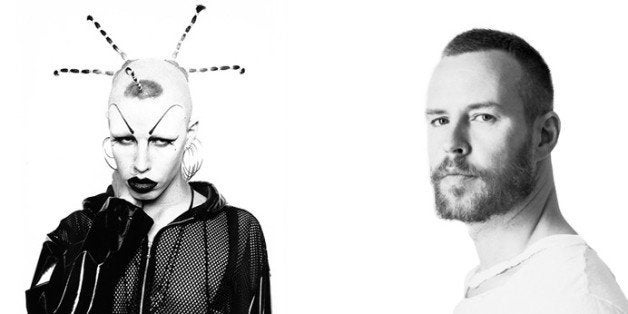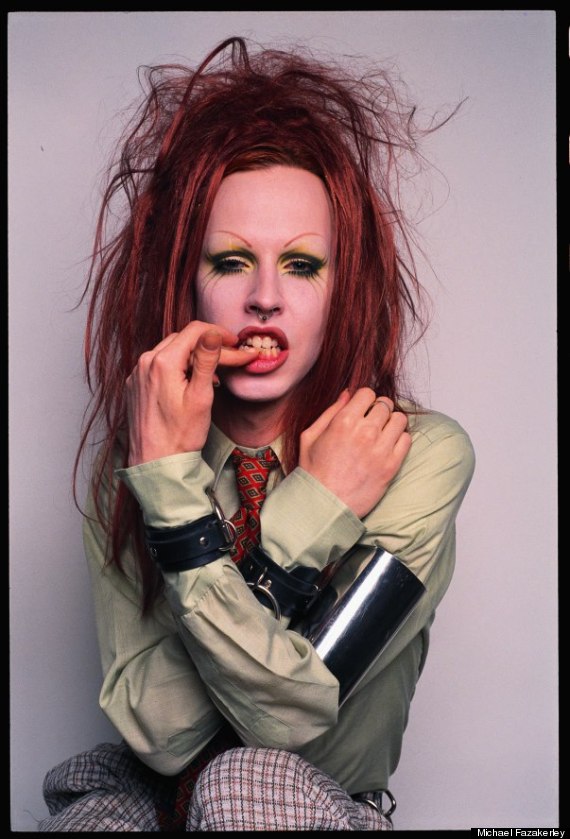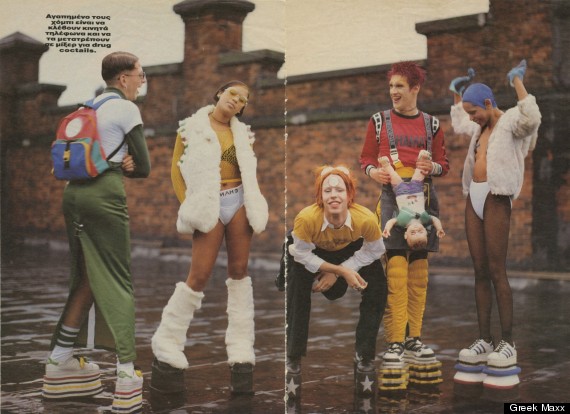
This is the third installment in HuffPost Gay Voices Associate Editor JamesMichael Nichols' 30-part series "After Dark: NYC Nightlife Today And Days Past" that examines the state of New York nightlife in the modern day, as well as the development and production of nightlife over the past several decades. Each featured individual in this series currently serves as a prominent person in the New York nightlife community or has made important contributions in the past that have sustained long-lasting impacts.
HuffPost Gay Voices believes that it is important and valuable to elevate the work, both today and in the past, of those engaged in the New York nightlife community, especially in an age where queer history seems to be increasingly forgotten. Nightlife not only creates spaces for queers and other marginalized groups to be artistically and authentically celebrated, but the work of those involved in nightlife creates and shapes the future of our culture as a whole. Visit Gay Voices regularly to learn not only about individuals currently making an impact in nightlife, but those whose legacy has previously contributed to the ways we understand queerness, art, identity and human experience today.
The Huffington Post: What led you to become an integral part of the Club Kids and nightlife during the 1990s? How did you come to embody Waltpaper as a persona?
Walt Cassidy: I came to New York as a teenage art student after spending high school in the hardcore music scene as a “political punk." I was fascinated with tribal culture, and had intended to move to Africa but got side tracked on a clubbing trip to NYC.
I enrolled at School of Visual Arts and had very little awareness of NYC club culture, so my entry into it was purely intuitive. I sought creative energy and like-minded people, and that was where I found them.
After I met Linda Simpson and Page at The Pyramid Club they gave me my first club job doing decor for a club called The Building. This was the beginning of an endless cast of characters that would shape, mentor and inspire me in New York.
I needed a catchy name. Since I made drawings and was doing club decor, I took on the name Waltpaper. It seemed to roll off the tongue and also would've been a good street tag.

How did things change or develop, both within the Club Kids and the culture of nightlife, throughout your time as Waltpaper?
Not long after setting up a studio up in the attic of The Building I got hired to go-go dance.
Music at that time was exploding in every possible direction... house, techno, trance, drum and bass, trip hop, break beat. The range and texture of sounds you heard in one night of clubbing was broad and cinematic, and I quickly found my spot in the cages hanging above the Limelight and Palladium dance floors, and on go-go boxes in practically every other club.
Honestly, I didn’t think life could get any better.
One by one I met a group of people my own age, each with their own unique character and charisma. These were the Club Kids. Just as the music was expansive, so seemed to be people’s identity expressions. New York felt effortlessly fertile.
Night culture had hosted an endless stream of creative personalities from the Jazz Era, the Beats, Warhol’s Factory, through Punk and Disco. So, there were high standards to live up to and I felt a clear sense of duty when I found myself in the middle of the Club Kids.
Patti Smith once said in an interview that there are always these pockets of time where everything sparkles, and things are done because people believe in something.
Each of us had come under the mentorship of Michael Alig, who was directing a fantastic melange of parties, events, summits, appearances and a magazine for Peter Gatien’s conglomerate of “mega clubs,” with the help of key people like Ernie Glam and Julie Jewels.
There was a dynamic system that operated and maintained this network of clubs. It was like the old Hollywood Studios. I was really blown away when I saw the professionalism and organization behind what was happening. Once inside of this powerhouse, I was very much protected and nurtured. I felt discovered.
I was only 20 years old at the time, passionate and creative but incredibly naive. I had no clue as to how to navigate the sea of opportunities in New York.
How did your experiences in nightlife inform your artistic endeavors during the Club Kids heyday?
My artistic focus during the Club Kids was on painting and illustration. I created an ongoing series of characters that were inspired by my friends and experiences within the club scene. These were used for t-shirts, magazines, skateboards and album covers.
I drew from the aesthetics and styles that were in constant flux, our ongoing social narrative, exploration of drugs and home life at the Chelsea Hotel.
I did random modeling gigs, appearances in music videos, commercials and talk shows. Gallery shows were organized that featured the Club Kids as art objects. There were Style Summits and tours that took us to other cites. We organized a gorilla-style group called Blueprint, which consisted of about 75 artists.
We were busy bees, to say the least. A tremendous amount of work went into appearing so flippant.
What purpose do you think nightlife serves in allowing queer and marginalized people to be creative within safe and supportive spaces?
It’s invaluable to have space and community in which to develop artistically and socially. It allows for the seeding and harvesting of ideas and the networking that accumulates around creativity.
Now, much of our experience is virtual and mobile. Part of that sacrifice is that things like nightclubs are perhaps not so necessary. We can get the networking, inspiration, community and resources online, but what is missing is the physical and ritual experience -- the communion.
For me, personally, this gap is now filled with gym and beach culture in New York, which seems to be thriving. Whatever I used to get at Limelight I now get it at Jacob Riis Beach, and what I don’t get there, I get online.
How do you think technology has augmented and shaped nightlife within the digital age? Do you think this is necessarily good or bad?
Every era and scene has built in obstacles, there to stimulate and challenge creatives. The potential is always present, as I mentioned earlier. I don’t feel that this challenge is taken up with much vibrance today in nightlife. Premature jadedness and territorial self-strategizing has diminished the drive that comes with community and shared creativity.
There is a general lack of elegance and invention, from my vantage point. Resources are not being pushed to their potential. People are so conscious of branding themselves that it paralyzes them from taking risks. Everyone wants to be sellable and palatable to the most mainstream trajectory, and the focus is too often on money and uniformity. Entitlement and laziness often prevail.
But, there are a handful of fantastic young individuals doing solid work, and it’s very exciting for me to see them developing. I follow them and enjoy watching them tackle the format in their own unique way. I love the work of Juliana Huxtable, La’Femme LaDosha, LE1F, designers BCalla and The House of Malakai, and DJ’s Amber Valentine and HD.
My focus has always been on the people who get in the trenches, which is never the populous.

How would you say nightlife today differs from your time as Waltpaper and a prominent figure in the scene?
The nightlife experience today is no longer linear. It is broken up into two parts. The participation, which largely consists of documenting the experience, followed by the process of offloading it into cyber space and having a secondary experience online.
The effects of the police state, two conservative mayors and the money agenda certainly have had their numbing effect. Perhaps with the new mayor, the city and nightlife will redefine itself.
I am not one to cry over spilled milk, and am more into imagining new ways to find creative balance. And with all due respect, nightclubs are for young people.
Do you feel like there is as much of an opportunity for a cultural institution such as the Club Kids to flourish today as there was in the 1990s?
I think there are always opportunities for new cultural institutions to be established and flourish. Our notions of time, space and tempo have changed and, as a result of that, creative aggression must move more quickly in order to be effective. The form must be mutable and flexible enough to stay interesting to an attention span that now requires constant change, and is somewhat gluttonous.
I enjoy nostalgia and history, but I am not a fan of retrogression. I believe in moving forward. I believe the best way to change something is to change the language around it. When we start using new language, the form is immediately and alchemically changed. The new institutions then coagulate around these changes.
During his feature earlier in this series, Michael Alig made this statement: "It seems like nightlife hasn’t really evolved in the past 15 years. I have a whole theory about that. My theory is that we are witnessing the end of our Western cultural dominance in the world and that we’ve gone as far as we can with our Western lifestyle as far as decadence, fashion, style, stuff like that. We’ve done every kind of fashion imaginable from miniskirts to maxi skirts, from peg leg pants to bell-bottoms, from black lipstick to glossy lipstick -- everywhere in-between. The only things we can do right now are kind of different variations of the same model and we’ve even done that already. " -- How do you respond to this? Do you agree with him?
I’m more optimistic, perhaps. I do think we are amidst times that can be likened to the Industrial Revolution. It is an axial time period, without a doubt. Michael’s statement reflects his personal crisis that he reached within club work. It mirrors his own experience, and is certainly a valid dilemma.
All creative people must take time and space for inspiration to present itself and mature. One of the problems today, is that the tempo has sped so fast that it doesn’t allow for the necessary creative pause. There isn't a whole lot of room for germination. Content is too often compromised, and culture does seem to be thinning as a result.
What projects are you currently working on?
The Nervous Peal Collection - Jewelry Project is currently featured at LALOON in Hudson, NY and will be launched in NYC at ODD May 20th.
I am releasing a new light based sculpture work in the exhibition "Trip the Lights Fantastic" curated by Natalie Kates Projects at High Line Gallery, opening May 29.
How prominent do you consider your time as Waltpaper to have been to the development of yourself as an artist today?
My time as a punk kid, and as one of the Club Kids, is elemental. It informs all of my work as an artist. The commitment to integrity and authenticity that stems from street and scene culture is reflected in the formal qualities of my artwork. It can be seen in the materials, and the objects feel occupied. There is a sense that life has been experienced within the work, fueled by personal narrative.
When I compare pictures of myself, as a Club Kid, to my current artwork and jewelry, there does seem to be a lot of continuity. The cycling, the concept of life as one master work, permeates.
For more from Walt Cassidy head here to visit the artist's website. Missed the previous installments in this series? Check out the slideshow below.


